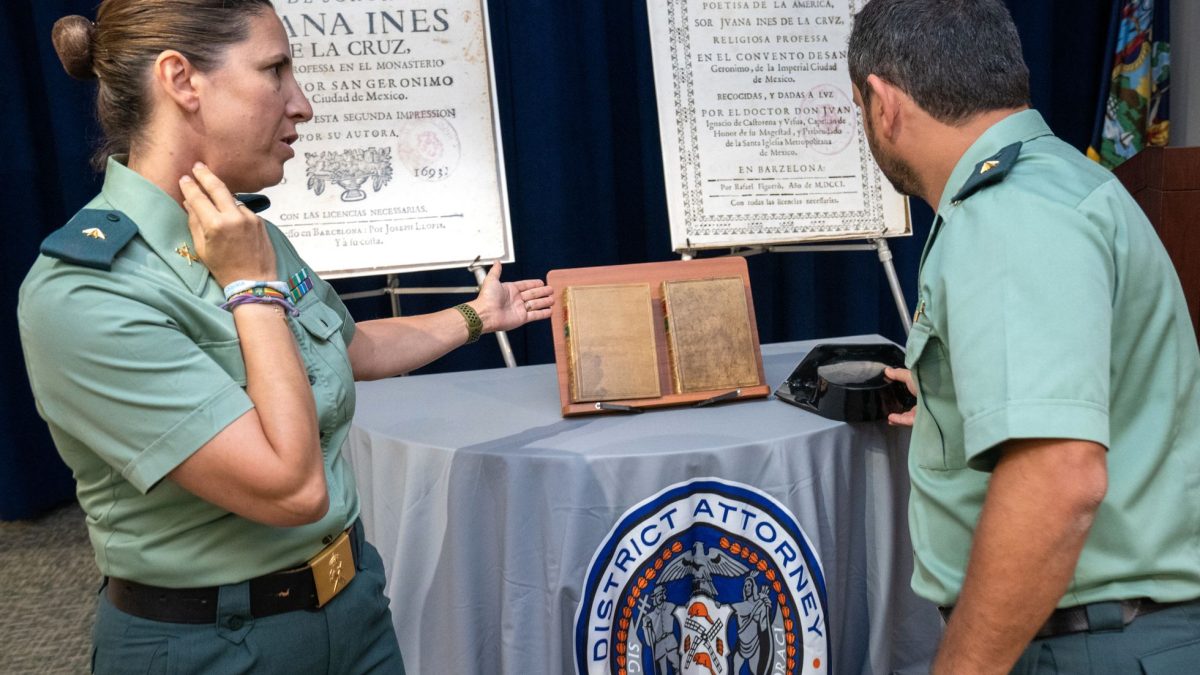
El convento de las Carmelitas Descalzas de Santa Ana (Sevilla) era el lugar donde se guardaban los cinco tomos del siglo XVII pertenecientes a la obra de Sor Juana Inés de la Cruz. Estos manuscritos contenían el sello ex libris, dado por las monjas del convento, que les otorgaba la propiedad.
Sin embargo, estas obras acabaron perteneciendo a un habitante de Cataluña durante diez años, para posteriormente, acabar en venta en una librería de Madrid. La investigación de la Guardia Civil reconoce que este comercio vendió, a su vez, la obra a un empresario mexicano y cuando falleció, fueron adquiridas por una casa de subastas estadounidense llamada Swann Aution Galleries en Nueva York. A finales de agosto, dos de los cinco tomos de la obra completa con el sello de propiedad del convento, llegaron a España, a la espera de un tercero, carente de sello del cenobio, pero que comparten sin duda, el origen.
La llamada operación Ellis, llevada a cabo desde 2021 por la Sección de Patrimonio Histórico de la Unidad Central Operativa de la Guardia Civil (UCO), está destinada a desmontar el sistema de contrabando de libros impresos en Madrid y Barcelona a finales del siglo XVII.
La puja fue intervenida por el Ministerio de Cultura y Deporte para frenar la venta de los ejemplares con un valor de entre 80.000 y 120.000 dólares, sobrepasando los 50.000 euros que establece la legislación española para considerarlo “delito de contrabando en lo relativo a bienes integrantes del patrimonio histórico nacional”.
Según el artículo 29.1 de la Ley de Patrimonio Histórico Español: “pertenecen al Estado los bienes muebles integrantes del Patrimonio Histórico que sean exportados sin la autorización requerida. Dichos bienes son inalienables e imprescriptibles”.
El robo y expolio de obras de arte, así como la alta presencia de la misma en el mercado negro hace evidente, no sólo, la aplicación de las políticas de protección de patrimonio, sino también la educación en fundamentos básicos como conocimiento, respeto y sensibilidad hacia los bienes culturales, entendiendo que son una fuente de recursos pertenecientes a toda una comunidad, digna de nuestra protección.
__
OPERATION ELLIS FOR THE RECOVERY OF TWO MANUSCRIPTS FROM THE 17TH CENTURY
The convent of the Carmelitas Descalzas de Santa Ana (Seville) was the place where the five 17th century volumes belonging to the work of Sor Juana Inés de la Cruz were kept. These manuscripts contained the ex libris seal, given by the nuns of the convent, which granted them ownership.
However, these works ended up belonging to an inhabitant of Catalonia for ten years, to later end up for sale in a bookstore in Madrid. The investigation of the Guardia Civil recognizes that this store sold, in turn, the work to a Mexican businessman and when he died, they were acquired by a U.S. auction house called Swann Aution Galleries in New York. At the end of August, two of the five volumes of the complete work with the property seal of the convent, arrived in Spain, awaiting a third one, lacking the seal of the monastery, but which undoubtedly shares the same origin.
The so-called Ellis operation, carried out since 2021 by the Sección de Patrimonio Histórico de la Unidad de la Guardia Civil (UCO), is aimed at dismantling the system of smuggling books printed in Madrid and Barcelona in the late seventeenth century.
The bidding was intercepted by the Ministry of Culture and Sport to stop the sale of the copies with a value of between 80,000 and 120,000 dollars, exceeding the 50,000 euros established by Spanish law to consider it a "smuggling crime in relation to goods that are part of the national historical heritage".
According to Article 29.1 of the Spanish Historical Heritage Law: "the State owns the movable goods belonging to the Historical Heritage that are exported without the required authorization. Such property is inalienable and imprescriptible".
The theft and plundering of works of art, as well as the high presence of the same in the black market makes evident, not only the application of heritage protection policies, but also education in basic fundamentals such as knowledge, respect and sensitivity towards cultural property, understanding that they are a source of resources belonging to an entire community, worthy of our protection.
__
